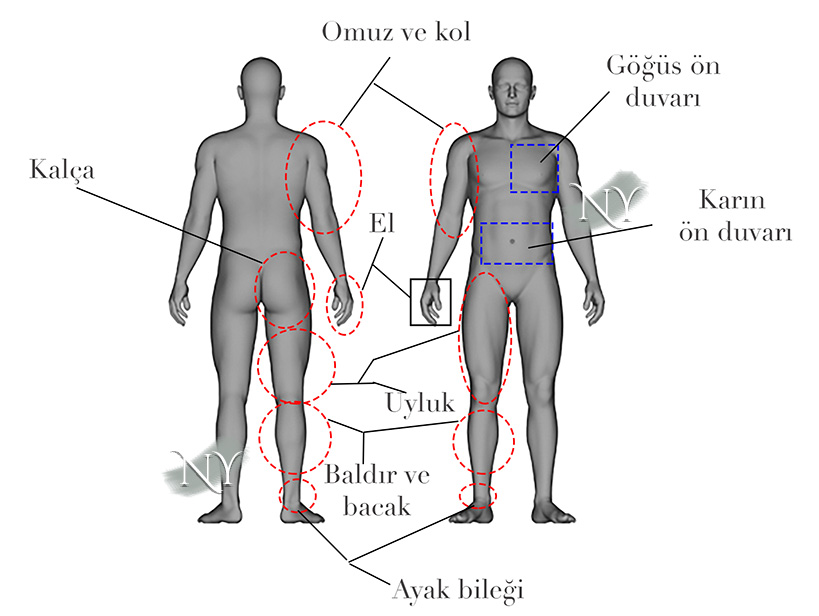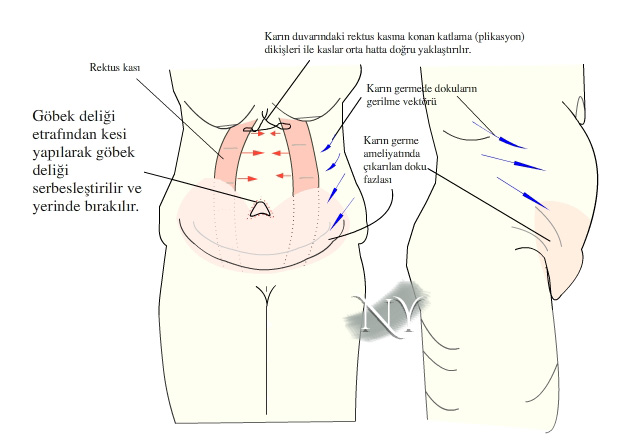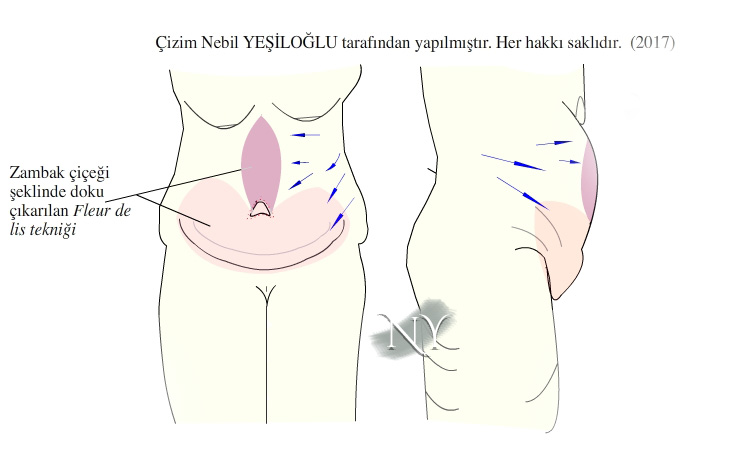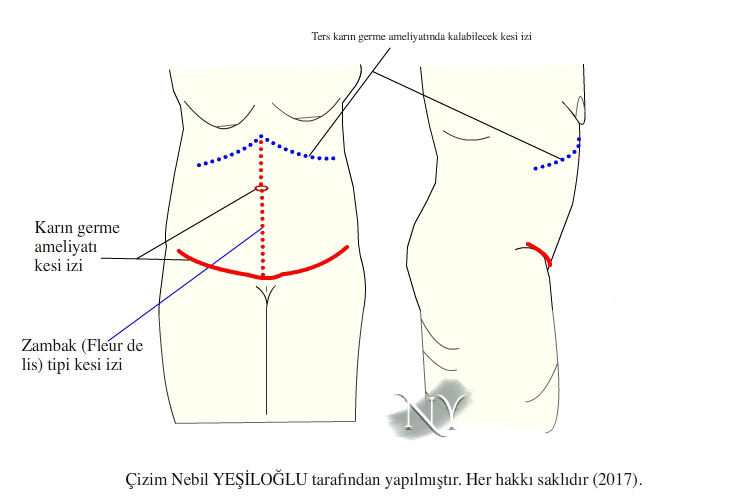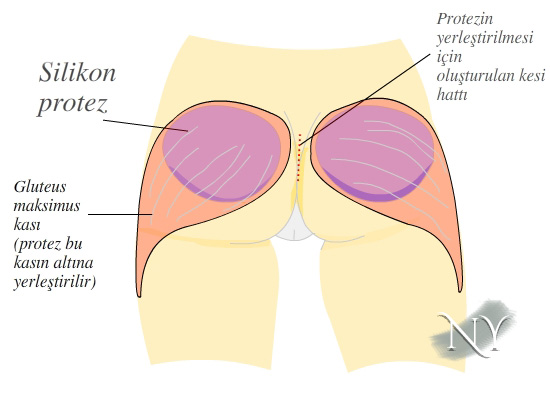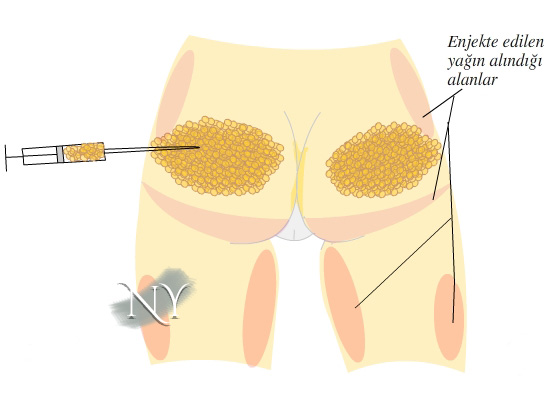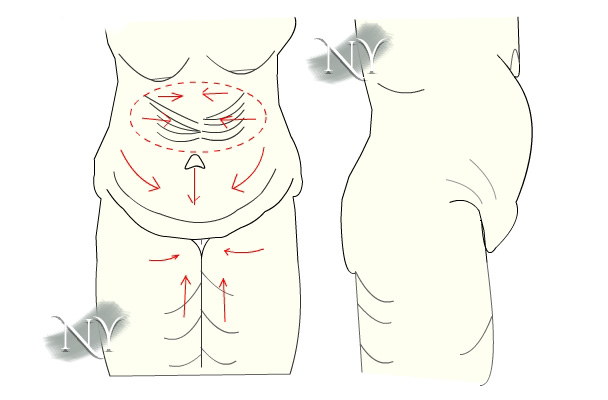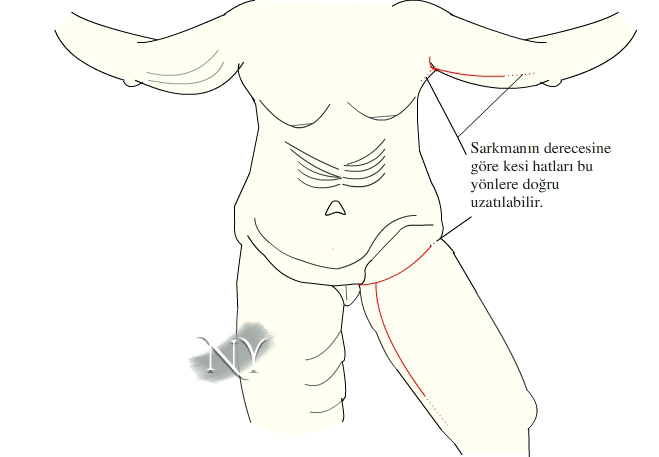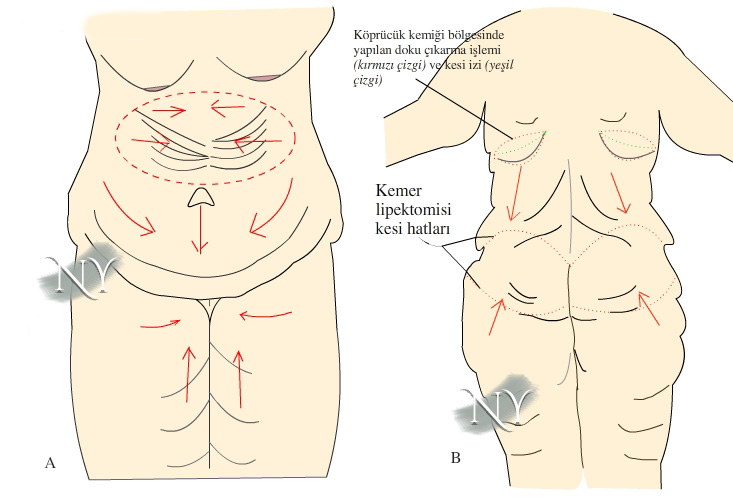Body Aesthetics
Everything you need to knowBody Aesthetics
Remember that although your excess tissue is removed during the surgery, body aesthetic surgeries are not performed for the purpose of losing weight, they only aim to regulate the body surface.
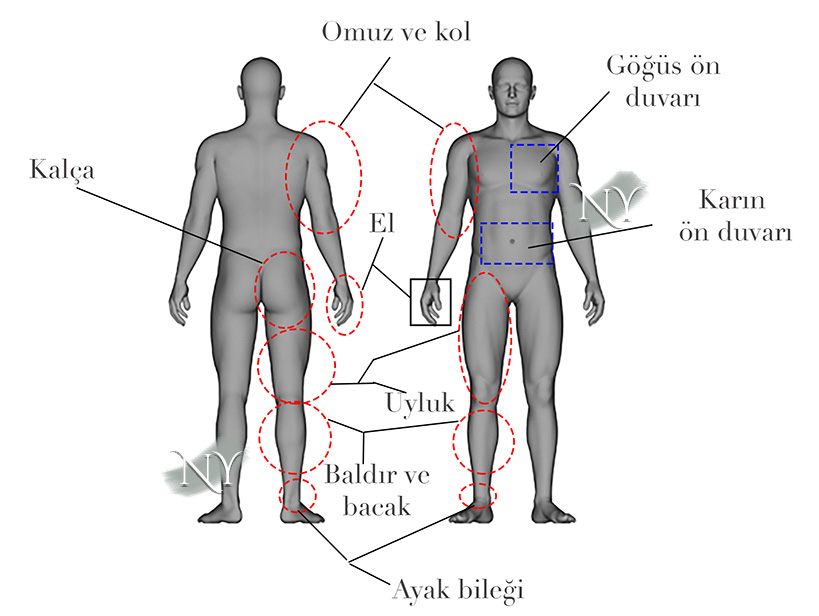
We can think of the body as the area between the line formed by the collarbones on the right and left above and the groin below.
Image Note: Areas treated in body aesthetics.
In this region, breast, abdomen, back and waist regions can be distinguished. All breast-related plastic surgery interventions are included in the relevant section. While there are post-bariatric surgeries such as liposuction in the back and waist area and belt lipectomy, the main treatment for sagging in the front abdominal area is tummy tuck surgery. Surgeries performed in the arm and thigh area are also combined, especially in body shaping surgeries performed after excessive weight loss. Therefore, arm, thigh and hip aesthetic surgeries are also mentioned in this section. Thread suspension techniques are among the non-surgical techniques applied especially on the hip, but they are generally reversible in a short time. That's why I don't recommend it very much.
Aesthetic surgeries of the body leave visible scars on the body. The areas where the scars will remain are related to the scope of the surgery and the degree of trunk deformity in the patient. While sagging only in the abdominal area will leave a scar, usually within the bikini area, after abdominoplasty surgery, widespread sagging involving the arms, thighs, abdominal wall, waist and hips will leave a more widespread scar.
Aesthetic surgeries of the body are performed in a period varying between 2 and 6 hours. For these surgeries, we want the person's body weight to remain constant for more than a year or to fluctuate within very narrow ranges. This indicates that the stability regarding weight continues and that the person pays attention to himself after the surgery. It is especially important that the ratio called body mass index (weight / height squared) is below 30. Remember that although your excess tissue is removed during the surgery, body aesthetic surgeries are not performed for the purpose of losing weight, they only aim to regulate the body surface.
Abdominal stretching surgery (abdominoplasty) is performed to treat remaining abdominal sagging after pregnancy or sagging due to weight loss.
The abdominal wall roughly consists of skin, subcutaneous fat tissue, and abdominal muscles from the surface to the deep. Abdominal sagging is observed as decreased skin elasticity, unchanged or increased subcutaneous fat tissue, and loosened abdominal muscles. I especially recommend strengthening the abdominal muscles with intense abdominal exercises in the 1-month period before surgery. Despite this, stitches called folding (plication) stitches are placed to eliminate the bulging of the abdominal muscles. Therefore, all activities that will strain the abdominal muscles should be avoided before the surgery, especially in the first month.
Image Note: Tissues removed during abdominoplasty and folding (plication) stitches placed on the rectus muscle
In tummy tuck surgery, the remaining part of the surgery consists of removing the excess skin and fat tissue and advancing the remaining abdominal tissue and stitching it to the groin area. While there is no need to intervene in the belly button in patients with limited sagging after the excess is removed, a new exit point to the belly button is created in the tissue carried down, especially in patients who need to remove a lot from the upper abdomen.
Although abdominoplasty surgery normally leaves a scar on the bikini line and around the belly button, a vertical incision line is also applied to perform a stretching procedure towards the mid-axis in patients where the tissues are loose in the horizontal axis, especially above the belly button. In this case, it is called the fleur de lis technique because the tissue removed resembles the shape of a lily.
Image Note: In the fleur de lis (lily flower) technique, tissue is removed in the vertical axis and tension is provided in the horizontal axis in the upper abdomen.
The resulting scar will be in the shape of an inverted letter T.
Image Note: In classical tummy tuck (abdominoplasty) surgery, the scar is in the groin, in the fleur de lis technique it is in the shape of an inverted T letter, and in reverse tummy tuck it is close to the end level of the ribs.
When tummy tuck surgery is necessary, it can be combined with liposuction surgery to facilitate the surgery.
In patients who have limited sagging in the area below the belly button and whose abdominal muscles are tighter, a surgery called mini-abdominoplasty, that is, mini tummy tuck, is performed in which only the skin and fat tissue is removed without changing the location of the belly button. The trace that will remain in this case is more limited.
Plastic surgery of the hip or butt is basically aimed at lifting and volume change, and various types of surgery have been defined for this purpose.
The area called hip, ass or butt covers the area limited by the waist above and the thigh below.
Image Note: Upper and lower borders of the hip or butt.
It consists of very strong muscles that enable the movement of the hip joint on the ground, and a skin and subcutaneous tissue that is well blooded by the vessels coming from these muscles. The hip is expected to have a distinctive bulge, especially in women. This bump is generally located in the upper half of the hip in the athletic body, and the aim of aesthetic surgery of the hip is to create this structure. For this purpose, the area can be supported with silicone prostheses or filled with fat injections. In patients with cellulite and size complaints, skin elasticity should be carefully evaluated. Although it is possible to reduce and shape the hips with the liposuction technique in such patients, it may cause sagging in patients who do not have elastic skin.
I recommend that patients whose hips have been lifted and added volume with a silicone prosthesis avoid intense physical activity in the early postoperative period. I have various suggestions regarding care, especially until the end of the first month.
In terms of hip lift surgery, the method that provides the best volume and verticality is by placing a silicone prosthesis. Lifting performed with silicone prosthesis is permanent. The silicone prosthesis is inserted into the area after creating a pocket under the gluteus maximus muscle through a 3-5 cm incision made in the fold between both hips.
Image Note: Hip lift surgery with silicone prosthesis
These surgeries require special equipment and experience. Since serious problems that may require removal of the implant may be encountered both in the early and late periods after subcutaneous prosthesis placement surgeries, submuscular prosthesis placement is preferred today. The patient should take good care to prevent infection in the wound line after prosthetic lift. At the end of the surgery, there will be tubes called drains that come from under the skin and draw dirty blood that may accumulate underneath, and these are removed the next day after the surgery. Again, at the end of the surgery, you will have a corset that I want you to wear for about three weeks. You can sit on your hip more comfortably after the first week, but care should be taken when sitting and standing. Over time, the prosthesis settles into the pocket it is in, thanks to the connective tissue capsule that will form around it.
In patients whose hips are planned to be enlarged with a silicone prosthesis, fat injection can also be applied to eliminate depressions in the skin, especially due to cellulite. Fat injection can be used to lift the hip without applying a silicone prosthesis, but its effect is largely reversible.
Image Note: Hip lift surgery with fat injection.
However, artificial fillings and silicone prosthesis surgery are not compatible and should never be applied together. It can cause serious infections and discharge. In patients with high fat tissue thickness in the buttocks, reduction can be performed with liposuction surgery, especially in combination with the hip and thigh areas.
Thigh and arm aesthetic surgeries are often combined with other cosmetic surgeries of the trunk. The healing process of these surgeries is faster and more painless than other surgeries of the body.
Thigh and arm lift surgeries are generally performed together with sagging in the abdomen and waist area, rather than alone, and the surgery duration may take up to 7-8 hours. In these surgeries, the abdominal tissue is pulled downwards to the mid-axis, and the sagging skin on the thighs and arms is pulled upwards and adapted to the membrane layers called fascia under the skin.
Image Note: Tightening axes in the abdomen and thighs in a patient with sagging after excessive weight loss.
The basic principles of thigh and arm lift surgeries are similar and in both surgeries, there will be incision scars on the inner side. In patients with excessive sagging, the incision line may shift towards the armpit or groin area. In cases of mild sagging, a horizontal scar remains in the armpit or groin, but as the degree of sagging increases, inner side incision lines approaching the elbow joint on the arm and the knee joint on the thigh may be required, and in this case, the scar left will be in the shape of the letter T.
Image Note: Scars left after thigh and arm lift surgery
In thigh and arm lift surgeries, when necessary, the thick fat layer can be thinned with limited liposuction. Liposuction, especially around the knee, allows us to obtain more ideal results.
Especially in arm lift (brachioplasty) surgery, excessive tension should be avoided in order not to negatively affect functions.
A surgery called belt lipectomy is performed in the treatment of sagging in the waist, hips and back area after weight loss. The aim here is to tighten the folds on the back and waist and to lift the hips higher.
Among the aesthetic surgeries of the body, arch lipectomy, which concerns the back and lateral face, is usually performed together with abdominoplasty surgery. However, if the patient has internal problems, arch lipectomy can be performed in a separate session.
Belt lipectomy can be seen as the back side parallel to the tummy tuck surgery performed on the front side. The main difference here is that the tissues are tighter than the abdominal tissue. Therefore, excessive tension should be avoided during planning. The incision scars in this area largely remain on the bikini line. Arch lipectomy is not effective on sagging in the shoulder blade area. These saggings are removed in an ellipse shape, provided that there is a separate incision scar.
Image Note: Tension axes on the front and rear of the body.
Detailed patient interview and examination is especially important before cosmetic surgery of the body. Various measurements are made on the patient, problems are identified, and treatment planning is made together.
Plastic surgeries of the torso are surgeries that can take a long time. Especially after surgeries that will last more than 5 hours, I recommend that the patient stay in the intensive care unit overnight for weight control and fluid electrolyte support.
In the interview before the plastic surgeries of the body, I question the previous surgeries and important diseases my patients have had. The location of the incision scars is important in planning, especially in patients who have undergone abdominal surgery. For example, the gallbladder surgery scar located on the upper right border of the abdomen is in the form of a reverse abdominoplasty, that is, the scar on the upper abdomen. It may require planning to stay within the border. The nutrition of the skin may be impaired due to the incisions to be made on the lower side. Again, in patients who have undergone laparoscopic intra-abdominal surgery, the tissues that connect the belly button to the body may be damaged during the surgery, and therefore the belly button, which is relocated during the tummy tuck surgery, may be lost. I also inform my patients about backup plans. Because the belly button has an important place in the aesthetic appearance of the abdomen.
Combining body aesthetic surgeries may be dangerous in patients with significant internal diseases. Especially diseases such as long-term uncontrolled diabetes, liver diseases, hypertension, heart failure, kidney failure may pose a danger in such major surgeries.
I request my patients to quit smoking before cosmetic surgery of the torso. Smoking may disrupt tissue nutrition and lead to wound dehiscence, infection or tissue loss. Therefore, it would be appropriate to quit smoking and other tobacco products at least 1 month in advance.
After cosmetic surgery of the body, patients should gradually return to their daily activities without tiring themselves.
The wound healing process after plastic surgery of the body takes approximately 2-3 weeks. Since the stitches are dissolved by the body, there is no need for an additional stitch removal process. Especially following the tummy tuck surgery, I ask my patients to walk slightly forward for a few days in order not to strain the abdominal stitches. I recommend starting work activities that will strain the abdominal muscles (such as using a broom, lifting heavy objects) at least 1 month later and gradually. Abdominal exercises can be started slowly towards 1.5 months.
In the early period after plastic surgery of the body, tubes called drains that carry dirty blood that may accumulate in the surgery area will come out of the skin. The drains are removed within 2-3 days and the patient becomes more independent.
After cosmetic surgery of the body, undesirable results (complications) may occur, as in all surgeries. The doctor-patient relationship is extremely critical in their management.
The main problems that may be encountered in the early stages of plastic surgery of the body are as follows:
- Accumulation of blood under the skin (hematoma): Bleeding that occurs in the form of leakage from a small vein or veins, usually due to situations that suddenly increase blood pressure in the body, such as strong straining or coughing. If the body drains are not sufficient to receive this blood, the patient may need to be taken to the operating room to drain the blood and control bleeding again. Especially in the anterior abdominal wall, there are many vessels with strong pressure, called perforators, extending from the underlying muscles to the skin. Any of these can become a focus of serious bleeding. Generally, patients recover well after evacuation of accumulated blood and bleeding control.
- Wound line problems: Infection and wound line separation in the wound line may occur in face lift surgeries, as in all surgeries. The wound edges are cleaned and antibiotic treatment is started and stitches may need to be placed again. Wound healing problems around the belly button and partial loss of the belly button may occur in the patient who underwent tummy tuck surgery. This situation is affected by factors such as the small size of the newly prepared hole for the belly button, opening the hole much higher than normal, previous laparoscopic surgery, and having undergone umbilical hernia surgery. In case of loss of the navel, dead tissues are cleaned and a new navel is created in its place.
- Deep vein thrombosis (DVT) and clot entry into the bloodstream (embolism): Clot formation due to decreased blood fluidity is a problem that can be seen more frequently, especially in patients over certain ages and with internal problems. Although there is no problem, in some patients, especially when intensive liposuction type surgeries are performed, clot (thrombosis) may form in the deep veins and a piece of this may break off and enter the general blood circulation and block vital vessels (embolism) in certain organs. Regarding this, such problems may arise despite taking various precautions before surgery. Especially in patients who request excessive fat removal, more than 6 liters may lead to an increased risk of DVT and embolism. In such patients, I keep the amount of fluid given after surgery higher. Apart from blood clot embolism, fat tissue can also leak into the vein and cause the same problems as fat embolism. I try to reduce this risk in patients with some additional medical measures (such as blood thinners, corset, lying with the knee bent at 10 degrees).
- Dislocation or infection of the silicone prosthesis: In surgeries where the hip is lifted with a silicone prosthesis, if the appropriate layer is not placed, the prosthesis may slip and come out by opening the suture line. It is therefore important to avoid intense physical activity, especially in the early stages of the surgery. Due to the area being close to the anus (anus), prosthesis infections may occur in patients who have not been cleaned properly before surgery. Another reason for this is the proximity of the pocket opened to this area in patients with pilonidal sinus or fistula type problems with inflammatory discharge. If the prosthesis becomes infected, it should be removed and the prosthesis should not be reinserted until the prepared pocket has been cleaned for a while.
- Inadequate correction: One of the common possible consequences of plastic surgery is the insufficient correction of the relevant complaint. This result can be expected in patients where planning is not done well, especially if the equipment used is inadequate. In such cases, your plastic surgeon is the address to solve the problem.
"Health is the most important thing you have in life!"
Contact us now to schedule an appointment.

